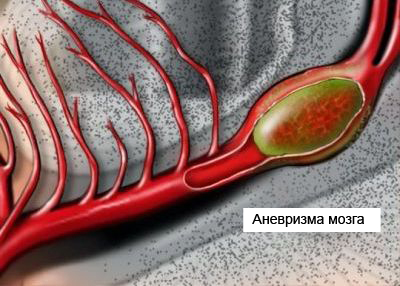Aneurysm mozga
Description of the brain aneurysm
Aneurysm mozga – weakening of blood vessels in the brain. Bulges, filled with blood can put pressure on nearby nerves. This can lead to rupture of the blood vessels and cause hemorrhage. Early detection and diagnosis can help prevent severe or fatal complications. Many aneurysms go unnoticed for life and do not cause symptoms.

Causes of a brain aneurysm
Aneurysms occur in areas, where the arterial wall becomes thin and weak. Thinning of the walls of the arteries as a result of an aneurysm can be caused by a number of factors. The main reasons are as follows:
- Congenital weakening in the artery wall;
- High blood pressure;
- Infection;
- Brain trauma and damage;
- Tumor;
- Plaque on the walls of arteries.
Risk factors
The following factors increase the likelihood of developing a brain aneurysm. These factors will also increase the likelihood of aneurysm rupture.. Adults are more likely to develop an aneurysm, than children.
- Old age;
- Genetic diseases (circulatory, connective tissue, or polycystic kidney disease);
- The presence in the family of patients with aneurysm;
- Smoking;
- Alcohol abuse;
- Drug abuse;
- High blood pressure;
- Tumors;
- Traumatic head injury;
- Arteriovenous malformations.
Symptoms of a brain aneurysm
These symptoms may be caused by other diseases. You must inform your doctor, if they came any:
- Headache, behind the eyeball;
- Numbness, sometimes on one side of the face and body;
- Weakness on one side of the body or face;
- Changes in vision;
- Drooping eyelids;
- Speech disorders.
Most aneurysms cause no symptoms, until strong expansion or rupture occurs. Symptoms of a ruptured or severely enlarged brain aneurysm:
- Headache;
- Nausea;
- Vomiting;
- Kryvosheya;
- Confusion or drowsiness;
- Loss of consciousness;
- Convulsions.
Diagnostics of the brain aneurysm
The doctor asks about the symptoms and medical history, and performs a physical exam. Tests may include the following:
- Photographing the brain, using computed tomography or MRI;
- Catheterization, MRI or angiography (to view arteries and veins);
- Analysis of the cerebrospinal fluid.
Brain aneurysm treatment
For known aneurysms, that pose no risk of rupture or enlargement, Treatment options include the following:
Monitoring
The doctor can track the progress of the disease, and decide in advance on further actions, if there is a risk of rupture.
Medications
Medicines are not used to treat the aneurysm directly. Medicines can be used to lower blood pressure, relieving pain, or to stop the side effects of an aneurysm, such as convulsions.
Endovascular embolization
During this procedure, a catheter is guided to the aneurysm. Coil, special liquid, or an air-filled balloon is used to fill the aneurysm and stop circulation, which leads to blood clotting. This procedure, perhaps, will have to be done more than once.
Surgery
Surgical options include microvascular clipping or occlusion.
- Brain aneurysm clipping – the neurosurgeon cuts off the blood flow to the aneurysm;
- Microvascular occlusion – a neurosurgeon places clamps on a blood vessel, leading to aneurysm. Sometimes blood flow is triggered bypassing the site of the aneurysm.
Prevention of brain aneurysm
In many cases, there is no way to prevent aneurysm from forming. To reduce the likelihood of a brain aneurysm or rupture, you must take the following steps:
- Lower high blood pressure;
- Give up smoking;
- Avoid using drugs;
- Consult a doctor:
- About the benefits and risks of oral contraceptives;
- About the safety of using aspirin or other drugs, which can thin the blood.
